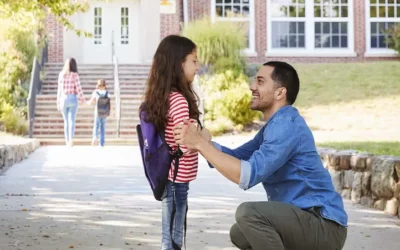In today’s digital age, where the Internet has become an integral part of our lives, it is crucial to prioritize online safety, especially for children. The online world offers numerous opportunities for learning, entertainment, and social interaction, but it also presents potential risks and dangers.
As parents and caregivers, it is our responsibility to ensure the well-being and protection of young minds in the vast realm of the Internet. In this blog post, we will discuss essential online safety tips for kids, emphasizing child online protection and safe online practices. plays a pivotal role in their overall communication skills. From the moment they begin to babble, their journey towards effective expression and comprehension commences.
Table of contents
Establish Open Communication
One of the fundamental aspects of safeguarding children online is maintaining open lines of communication. Encourage your child to talk to you about their online experiences, both positive and negative. Create a safe and non-judgmental environment where they feel comfortable discussing any concerns or issues they may encounter while using the Internet.
Effective communication plays a pivotal role in children’s education, fostering a well-rounded learning experience and holistic development.

Teach the Basics of Online Privacy
Children must understand the importance of protecting their personal information online. Ensuring child safety in the digital age involves a vigilant approach to online privacy. Here are five basic points to teach kids about online privacy:
1. Personal Information is Private: Explain to kids that personal information, such as their full name, home address, school name, phone number, and passwords, should be kept private. They should not share this information or any other personally identifiable information (PII) with anyone online unless a trusted adult (parent or guardian) gives them permission.
2. Be Cautious with Social Media: If they use social media or online platforms, teach them to be cautious about what they post. Remind them that anything they share online can be seen by others, even if they think it’s private. Encourage them to think twice before sharing something that could be embarrassing or harmful.
3. Understand Privacy Settings: Help kids learn about privacy settings on websites, apps, and social media platforms. Show them how to set their accounts to the highest level of privacy possible. Explain that these settings can help control who can see their information and posts.
4. Be Wary of Strangers: Emphasize the importance of not talking to or meeting up with strangers they meet online. Explain that not everyone online is who they say they are, and some people may have bad intentions.
5. Avoid Clicking Suspicious Links: Teach them not to click on links or download files from unknown sources. Malicious links or downloads can harm their devices or compromise their personal information.
Bonus Point: Encourage open communication with you or another trusted adult. Let them know that if they ever feel uncomfortable or encounter something online that doesn’t seem right, they can come to you for guidance and support.
By teaching these basics, kids will develop an understanding of the importance of online privacy and how to stay safe while using the internet.
Set Clear Boundaries
Setting clear boundaries and guidelines for internet usage is essential to ensure kids’ safety and responsible online behavior. Here are the top three points to consider:
- Screen Time Limits: Set specific time limits for internet usage each day. Encourage a healthy balance between online and offline activities. Consider factors such as their age, schoolwork requirements, and other extracurricular activities when deciding on appropriate screen time limits.
- Approved Websites and Apps: Identify a list of approved websites, apps, and online platforms that are safe and suitable for your child’s age. Make sure they understand that they should only use these pre-approved resources. Regularly review and update the list to keep it relevant and age-appropriate.
- Internet Use in Common Areas: Encourage internet usage in common areas of the house, such as the living room or kitchen, rather than in bedrooms or private spaces. This way, you can easily monitor their online activities, offer guidance, and be available for any questions or concerns that may arise.

Educate about Cyberbullying
Educating kids about cyberbullying is crucial to help them recognize and address this harmful behavior. Here are the top five points to teach them:
- What is Cyberbullying: Explain to kids that cyberbullying is when someone uses technology, such as social media, texts, emails, or online games, to repeatedly and intentionally hurt, harass, or embarrass others. Help them understand that cyberbullying is wrong and can have serious consequences for both the victim and the perpetrator.
- Recognizing Cyberbullying: Teach kids how to recognize cyberbullying. Signs may include receiving mean or threatening messages, being excluded from online groups, having rumors spread about them, or encountering hurtful comments on social media. Encourage them to speak up if they experience or witness cyberbullying.
- Safe Online Practices: Promote safe online practices, such as keeping personal information private, using strong passwords, and understanding privacy settings on social media. Emphasize that they should not share passwords with anyone, even their best friends, as this information can be misused in cyberbullying situations.
- Responding to Cyberbullying: Advise kids not to respond to cyberbullying messages or comments. Instead, encourage them to save evidence of the bullying, block or unfriend the person responsible, and report the incident to a trusted adult, such as a parent, teacher, or school counselor.
- Empathy and Kindness: Teach kids the importance of empathy and kindness online. Encourage them to treat others with respect and to stand up against cyberbullying by supporting the victim and reporting incidents promptly.
Remember to maintain open communication with your kids about their online experiences. Encourage them to talk to you about any concerns they have, and assure them that you are there to support and guide them through any cyberbullying situations they may encounter.
Encourage Critical Thinking
Critical thinking is a valuable skill for kids to develop, especially in the digital age. Here are the top three points to encourage critical thinking skills for kids:
- Question Everything: Teach kids to question the information they come across online. Encourage them to ask themselves who wrote the content, what the source is, and whether it comes from a trustworthy and reputable website. Explain that not all websites or sources provide accurate information, and they should verify facts before accepting them as true.
- Recognize Biases and Perspectives: Help kids understand that everyone has their own biases and perspectives, which can influence the way information is presented. Encourage them to consider different viewpoints and to be aware of any potential biases in the content they encounter. By doing so, they can develop a more well-rounded understanding of various topics.
- Check for Evidence and Sources: Show kids how to look for evidence and credible sources to support the information they find. Teach them to cross-reference information from multiple reputable sources to ensure accuracy. Explain the difference between opinion-based content and evidence-based content, helping them distinguish between personal beliefs and verified facts.
Promote Responsible Social Media Use
If your child is using social media platforms, guide them on responsible and safe practices. Teach them about privacy settings, the importance of not accepting friend requests from strangers, and the potential consequences of sharing inappropriate content. Encourage them to think before posting anything online, as digital footprints can have long-term implications.
Install Parental Controls
To install parental controls for internet safety, first, set up a filtering system to block inappropriate content based on your child’s age. Utilize software or router settings to limit screen time and establish specific online hours. Create user accounts with limited privileges for kids to prevent unauthorized access.
Monitor browsing history and use activity logs to track their online behavior. Enable SafeSearch on search engines to filter explicit content. Regularly update passwords and review security settings. Discuss these measures with your child, fostering open communication and educating them about responsible internet use. Parental controls play a vital role in safeguarding kids while they explore the digital world.
Teach Online Stranger Danger
“Online stranger danger” is essential for kids to understand. They should never share personal information or engage with strangers online. Explain that people may not be who they claim to be. Teach them to use privacy settings on social media and limit friend requests to people they know in real life. Encourage open communication so they can share concerns or encounters with strangers.
Remind them that they should never meet someone they’ve only met online without a trusted adult present. By staying cautious and aware, they can enjoy a safe online experience and avoid potential risks associated with interacting with strangers on the internet.

Stay Informed
As technology and online platforms evolve rapidly, it is crucial for parents and caregivers to stay informed about the latest trends, apps, and potential risks. Regularly educate yourself about the popular platforms your child uses and familiarize yourself with their privacy settings and safety features.
Be a Positive Role Model
Being a positive role model is crucial as children learn by observation. Demonstrate respectful online behavior by using social media responsibly and being kind in your interactions.
Show them the importance of balancing screen time with other activities. Talk openly about internet safety, privacy, and critical thinking, involving them in discussions about appropriate online conduct. Model healthy boundaries by limiting your own excessive device use and being present during family time.
Exhibit empathy and understanding when they encounter challenges online. By being a positive role model, you instill essential values and behaviors that will guide them towards responsible and respectful internet usage.
Conclusion
In conclusion, ensuring the online safety of children is of paramount importance in today’s digital landscape. By establishing open communication, teaching the basics of online privacy, setting clear boundaries, and promoting responsible Internet use, we can shield young minds from potential online risks.
By staying informed, being involved, and being positive role models, we can empower children to navigate the online world safely and confidently. Let us work together to create a secure and nurturing online environment for our children, where they can explore, learn, and grow while being protected from harm.
Join the revolution in education with Brightchamps. Our courses in robotics, coding, and financial literacy empower kids to become confident and capable learners.
Navigating the complex landscape of education and child development can be daunting, but with the BrightChamps blog page at your fingertips, you’ll find clarity and confidence in your journey. Unveil articles that delve into the latest advancements in pedagogy, providing actionable strategies to enhance learning experiences for children of all ages.
Frequently Asked Questions
A1: The appropriate age for children to start using the Internet varies depending on their maturity level and ability to understand and follow online safety guidelines. Generally, around the age of 8 or 9, children may begin to explore the Internet with close supervision and gradually gain more independence as they grow older.
A2: Monitoring your child’s online activities is important for their safety. However, it’s essential to balance monitoring with respecting their privacy. Discuss the importance of transparency and trust with your child. Utilize parental control tools and establish clear guidelines about what is acceptable online behavior. Regularly communicate with your child about their online experiences and address any concerns or issues that arise.
A3: Yes, there are numerous educational resources available to teach children about online safety. Many organizations and websites provide age-appropriate materials, games, and interactive activities that can help children learn about online safety in a fun and engaging way. Common Sense Media, NetSmartz, and the National Online Safety website are excellent resources for parents and educators.
A4: Protecting your child from cyberbullying requires a proactive approach. Start by educating your child about cyberbullying and how to recognize and respond to it. Encourage them to maintain open communication with you or a trusted adult if they experience or witness cyberbullying. Teach them to save evidence and block or unfriend individuals engaging in harmful behavior. Report incidents to the relevant platform or school authorities, and work together to address the issue and provide emotional support.
A5: Limiting screen time is beneficial for children’s overall well-being, including their physical health, mental health, and social development. While the exact time limits may vary depending on the child’s age and circumstances, it is generally recommended to set reasonable restrictions on screen time. Encourage a balanced lifestyle that includes physical activities, face-to-face interactions, and other offline hobbies and interests.


 We are an army of educators and passionate learners from BrightChamps family, committed to providing free learning resources to kids, parents & students.
We are an army of educators and passionate learners from BrightChamps family, committed to providing free learning resources to kids, parents & students.













